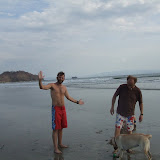
Wow....what a movie! I think I can safely say that I'll never see another movie like that again! Filmed entirely in Mayan, the viewer relies soley on subtitles to understand the dialogue, yet words alone cannot describe what transpired for the last 2+ hours. I had few preconceptions about this flick, other than some peripheral 'warnings' from some in academic circles about how accurate the depiction of Mayan civilization really was, and by those who thought the violence was a bit much.
Let me start out and say that the latter statement is essentially true. This is one violent movie.....one of the most graphic, gory displays you could hope (or hope not) to see. For me, this wasn't a big deal....you make a movie about an ancient civilization, you should expect to see things that make you cringe. I wasn't disappointed, although it didn't exactly make me jubilant to see beating hearts ripped from chests, severed heads, innocent women and children maimed, etc....
So....what was the point? What was that crazy, thirsty, controversial aussie, Mel Gibson up to when he made this movie. Not unlike Kevin Costner's Dances With Wolves and Clint Eastwood's latest effort regarding Iwo Jima, it seems that Gibson wanted to tell a non-'Eurocentric' story. This one happens to focus on the Mayan civilization immediately prior to European discovery. To this end, he succeeded. Not unlike his Passion of the Christ, he pushes the envelope, makes people angry, but most importantly, he makes us think.... For me, this effort exceeds his portrayal of the Crucifixion.
Less constrained by the dynamics of Biblical interpretation, he is given freer rein to explore a story of a modest band of hunter-gatherers living on the fringe of a great Mayan city-state. Forgive me if I glaze over this a bit, as I'm not entirely sure what structural form this entailed, but suffice it to say, our protagonists did not consider themselves to be akin to their 'urban' conquerors. Apparently, they spoke the same language, wore few clothes, had more tatoos than Ozzy Osbourne, and had a propensity for violence...after that, all similarities cease. So, at any rate, the story begins with a group of local men from the village/settlement, that happen upon another 'tribe', apparently harangued and disheveled from some unknown force of change.
We find out the next day what that force is to be, as a group of marauders from the Mayan city-state sack the village, raping, plundering, murdering, essentially causing more mayhem in 15 minutes than in most decent war movies. The whole scene made me question the barbarity of mankind (if I am to take Gibson at his word about this film). Many 'war movies' try to capture this without being cliché, but few succeed, where this one does. So, all of the surviving villagers are rounded up to be brought back to the temple. Before succumbing to the invaders, our protagonist successfully hides his pregnant wife and small child in a well. This sets up the rest of the movie, as he tries to escape and reunite with his family.
So...after escaping the Mayan sacrificial alter (due to a solar eclipse of all things!), a cadre of Mayan warriors, and other maladies, our protagonist finally makes it back to 'his forest'. He takes two arrows to the chest, avoids drowning in quicksand, gets a lucky break with poisonous snakes, frogs, a panther, a giant waterfall, the ominous arrival of Spanish conquistadors, and much more. All of this transpires in two days! This series of events make up the bulk of the story.
Incredibly, this all seems to work in the storytelling. Gibson has recreated 'another world', one that I need to think about more closely when I engage in conversations about 'ancient history'. I once had a professor tell me that a contemporary American is more culturally akin to contemporary Africans/Asians, etc... than to our own 'founding fathers'. Yet, we identify ourselves more closely with our historic breathren. I question this...Is it a good idea to apply moral reletavism to history? I think not....and Gibson's films remind us of this fact. He also stresses that Mesoamerica was not some harmonious, idyllic counterpoint to the disease, debauchery, and brutality of Europe in the Middle Ages.
For me, this film follows an important cinematic progression, regarding the issue of indigenous peoples in the Western hemisphere. Natives are not merely portrayed as inferior savages, in need of European 'salvation', nor are they seen as overly sympathetic, as portrayed in Costner's film 17 years ago. Instead, this is a human story. I commend Gibson for making this movie. Seen through the lens of one man, and his family, trying to survive the game of life, it is easy to see 'predators' at every turn. Some things never change in human civilization....




1 comment:
Gibson shakes us with this film. Theories based upon the legend of "el buen salvaje" must be reviewed. Since C. Colón "re-discovered" America, and described it like a paradise; later, fray Bartolomé de las Casas with "Brevísima Relación de la Destrucción de las Indias"; Moreover, theologians of the Escuela de Salamanca, the Junta de Burgos and Junta de Valladolid that discussed about the Leyes de Indias on XVI century; Finishing whit Rousseau and Locke talking about the kindness of the nature humanizes.
All of them just showed the weakest and human part of these aborigens.
But Gibson shows something more similar to the wild reality of the Mayan civilization before disappearing.
I believe that to judge the History is very difficult. Always we enter slippery and dangerous areas.
The critical review of the History is a good exercise to share taking a few drinks with the friends.
Nothing else.
Post a Comment